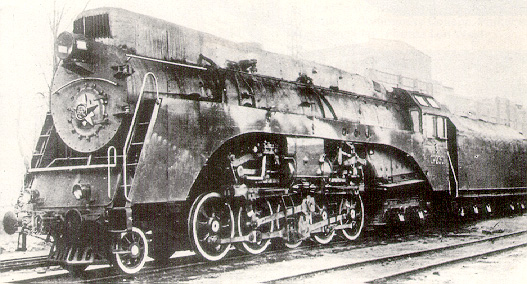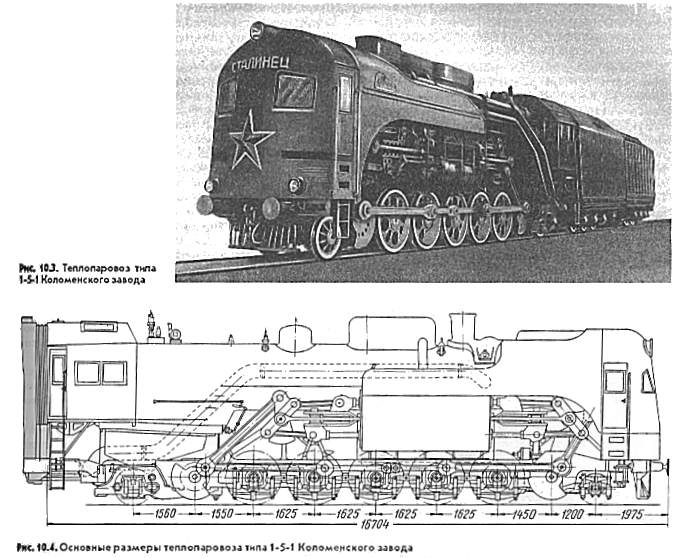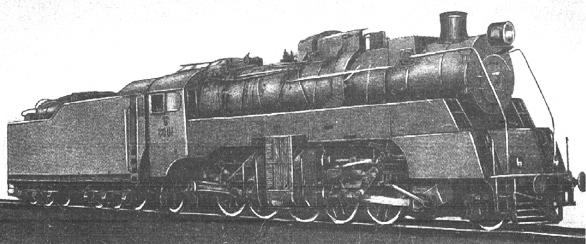
| Left: The AA20-01 4-14-4 locomotive
|
|

THE OR23-01 OPPOSED-PISTON STEAM LOCOMOTIVE. 1949
I assume the point of opposed pistons was to obtain balance of the fore-and-aft forces, which would mean a reduction in wheel balance weights, and hence in hammer-blow on the track. There still seem to be heavy connecting rods going back-and-forth, so I'm not too convinced this was a sound plan. It seems to have been exclusively a Russian scheme.
This was the only conventional steam opposed-piston design; see below for steam-diesel versions.
 |
| Left: The opposed-piston OR23-01 steam loco of 1949. This experimental 2-10-4 was designed by N A Turkin and M N Anykeev, and built at the Oktober Revolution (OR) Locomotive Works at Voroshilovgrad. No more were built.
.
Below: The mechanism of OR23. The overhung crank on the centre axle reverses the direction of movement of one of the opposed pistons.
|


TEPLOPAROVOZ! THE 8000 2-8-2 OPPOSED-PISTON STEAM-DIESEL LOCOMOTIVE: 1939
Between the world wars, the Russians had followed with interest experiments with steam-diesel combinations in other parts of Europe; the Italian Ansaldo 4-6-2 of 1926, and the Kitson-Still Locomotive of 1928. See also the Still Steam-Diesel system as applied to ships.
 |
| Left: Steam-diesel 2-8-2 opposed-piston freight locomotive No 8000, built 1939 at Voroshilovgrad Works. The name on the front is "Stalinets" ie a follower of Stalin.
Teploparovoz is Russian for "Diesel-Steam".
In this case the outsides of the pistons were acted on by steam and the inner sides by internal combustion. Fleming states this system was later replaced by uniflow steam cylinders.
The 8000 was completed in September 1939 at the Voroshilovgrad Works. It was intended to give 3000 Hp and run at a maximum speed of 130 km/hr. It was to be steam powered up to 20 km/hr, above which the inner volume between the two opposed pistons was to become the diesel combustion space, while steam continued to drive the outer piston faces on their inward movements.
|
The locomotive made its first trial run on 18 October 1939, and in November ran trials on the North Donetz and Southern railways.
 |
| Left: The mechanism of 8000
The jackshaft on the right reverses the direction of movement of one of the pistons, to give an opposed-piston action.
|
After WW2, the 8000 was reappraised, and tested again in 1946. It was put into store in 1948 and never ran again. It had many problems; for example, its 25 tonne axle-loading was too great for the track, the cylinders were prone to cracking, and it rode badly on the rails.

TEPLOPAROVOZ! THE TP1-1 2-10-2 OPPOSED-PISTON STEAM-GAS LOCOMOTIVE: 1940
The TP1-1 has been "Coming soon" for some nine years. This shameful record has now been ended.
Unlike the other locomotives on this page, the TP1-1 was a cab-forward design. It was intended to run on anthracite, which was pulverised and gasified to fuel the internal combustion cycle, while the pulverised coal left over from this process was fed to the firebox of the boiler to raise steam. As if this was not complicated enough, it also carried a condenser and consequently a turbine-driven fan in the smokebox was required to create draught. Work began on designing this machine at Kolomna locomotive works on July 8th, 1939. It was supposed to be at least as powerful as one of the FD (for Felix Dzerzhinsky, founder of the NKVD) class 2-10-2s; you can see an illustration of one of those splendid machines here: Felix Dzerzhinsky 2-10-2 (external link)
 |
| Left: The TP1-1 2-10-2 opposed-piston steam-gas locomotive
The cab at the front is for the driver, but there was also a cab at the back for the fireman tending the boiler and gas generator. Presumably, given the complications of steam-gas operation, effective communication between the two cabs was essential, but nothing is currently known about how (or indeed, if) this was accomplished.
The bodywork was painted dark blue, and the driving wheels red.
Images from 'Locomotives of the Nation's Railways 1845-1955' by Vitaly Rakov, published (in Russian) in Moscow in 1995.
|
TP1-1 was intended to develop 3,000-3,500 HP, with 2,000 HP from the gas cycle and 1,000-1,500 HP from steam. It had a total of 8 pistons, powering the wheels via a jackshaft and rocking-lever at each end; note there were 4 crossheads per side. The steam cylinders used Marshall valve gear, while the gas cycle was two-stroke and fuel was supplied by what literally translates as 'a gas and air turboblower' at 1.2 kg/cm2. The gas generator was in the tender and provided 4,750 m3 of gas per hour. Hoped-for efficiency was 11%, but the Rakov text is silent as to whether this figure was achieved. It is suspected not.
Work proceeded quickly and TP1-1 made its first journey on December 26th, 1939, when it ran down the line from Golutvin station (the nearest to Kolomna works) towards Ryazan. Deadlines tended to be rather inflexible at that point in Soviet history, but speed of construction seems to have been aided by the fact that a lot of standard components from various production classes of steam locomotives were incorporated.
It was then taken to the test-track at Shcherbinka, due south of Moscow (still in operation today) and made 76 trips, totalling 1,790 kilometers. It was not a success. It only worked properly at speeds of 25-30 km/h and less. Once it got up to 40-45 km/h, the gas cycle would pack up after about 10-15 mins and the gas-air mixture would ignite prematurely on admission to the cylinders. Apparently Kolomna works had sorted out the bugs by early 1941 by shortening the piston heads and thus reducing the compression, but then the war intervened and TP1-1 was quietly forgotten about.
Confusingly, this locomotive was also called "Stalinets", the name carried on the forward cab.

TEPLOPAROVOZ! THE 8001 2-10-2 OPPOSED-PISTON STEAM-DIESEL LOCOMOTIVE: 1948
 |
| Left: Steam-diesel opposed-piston passenger locomotive No 8001, wheel arrangement 2-10-2, built 1948 at Voroshilovgrad Works
This was the third and last teploparovoz prototype to be built.
At the end of 1940 preliminary design work began at Voroshilovgrad, but was halted during the war. Work resumed in 1945 and No 8001 finally emerged from the works in September 1948. It has been described as "almost a complete disaster", so one is rather left wondering what did go right; no details have so far been found. It is however certain that it was the last Russian steam-diesel experiment.
|
The complicated drive mechanism of 8001 was similar to that of TP1-1 above, except that the cylinder assemblies were lowered to wheel level.
 |
| Left: The drive mechanism of 8001
With eight cylinders, eight crossheads, and four extra rocking levers it does not look promising from the point of view of maintenance.
|

RAILWAY OPERATION IN SOVIET RUSSIA
I feel compelled at this point to recount an event which may give some flavour of railway operations in Soviet Russia. In March 1937 a railway accident occurred in Siberia; the details of the event are so far obscure, but what is known is that 72 railway officials were held responsible and were executed. As Peter Semmens put it: "One's mind boggles at trying to imagine the circumstances whereby that number of individuals could have actually had a hand in causing an accident."
Source: "Railway Disasters of the World" by Peter Semmens, pub Patrick Stephens Ltd 1994

Bibliography:
"Locomotives", by A M Bell. 5th Edn. pub Virtue & Co, 1946
"Russian Steam Locomotives", Fleming. pub J.Marshbank 1960
"Locomotives of the Nation's Railways 1845-1955" by Vitaly Rakov, 1995
"Elements of Locomotive Development in Russia & The USSR" ed Keith R Chester, Trackside Publications























